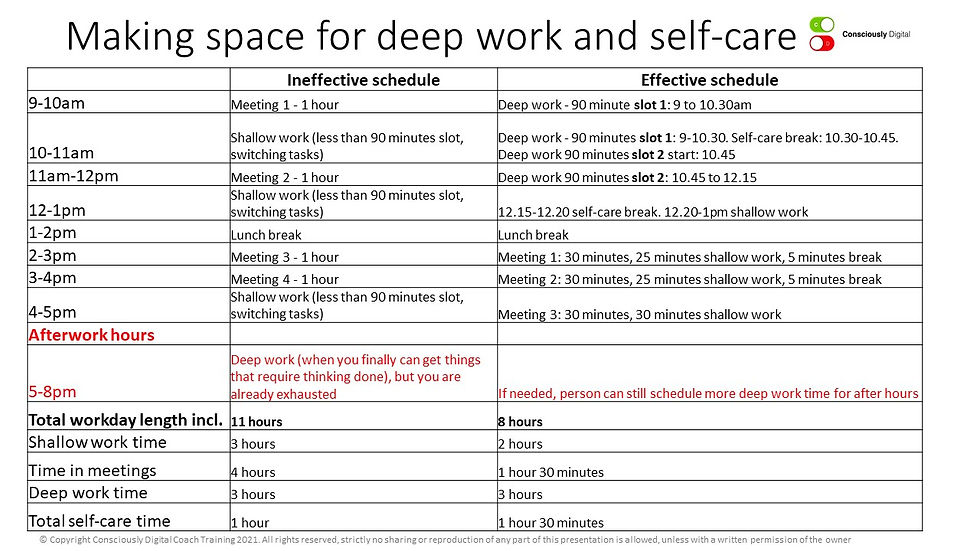Get time for deep work and self-care
- Anastasia Dedyukhina

- Jun 22, 2021
- 2 min read
Over the last year we have been getting similar complains from clients all around the world.
"I am spending longer hours working, but still not accomplishing much. I am tired and overwhelmed, how do I reduce my screen time?"
Our first response is, it's more than just screen time. It's natural to think that you get tired because you spend longer hours at the computer. However, how you spend these hours is more important.
These are typical problems that we see over and over again in employees all around the world that cause digital fatigue:
1. not scheduling time for deep work
2. too many meetings and/or scheduling meetings back-to-back
3. not taking mini-breaks nor larger breaks
4. not separating from your devices after working hours
Let's look into these more in detail.

1. Lack of deep work and switching costs
The term “deep work” was first introduced by MIT researcher Cal Newport and describes one’s ability to focus without any distractions on a cognitively demanding task that often produces the most value (for example, preparing quarterly forecast). Newport suggests at least 90- minute time slots of uninterrupted time and attention, as often one needs time to get “in the zone” for deep work.
The opposite to deep work is “shallow work”, which does not require big cognitive effort and can be performed by anyone. This could include simple admin tasks like planning a meeting or sending emails.
When you are interrupted during your deep work, your brain goes in the "shallow" mode and you lose part of the information you've been working with. Additionally, switching between tasks has been proven to have a mental cost and increase levels of stress hormone cortisol (and sugar cravings) already after 20 minutes of interrupted performance.
Open your calendar and calculate, how many hours this week you spent on deep vs shallow work. What do you need to adjust on your schedule to have more deep work?
2. Too many meetings or scheduling them back-to-back
When calls are scheduled one on top of the other, you are more likely to experience digital fatigue. To avoid it, regular breaks of at least 10 minutes need to be incorporated between the calls. Try not to have more than 3-4 meetings daily on a regular basis.
3. Not taking mini-breaks or larger breaks (for lunch for instance)
An average person before the pandemic had been spending about 8.9 hours each day sitting, and in 2020-2021 people moved up to 50% less. When working from home, people tend to spend longer hours seated, as they don’t commute. Young individuals are especially prone to sit more.
4. Not separating from your devices after working hours
Our brain needs a signal that "work is over", so that it can relax. The mere expectation of work-related email outside of working hours can increase stress and fatigue not only in you, but in your close ones. If you cannot control, who is asking you for what, you are losing your autonomy, which has been shown to directly cause exhaustion.
If you take these four things into account, you would be more efficient online and have to spend less screen time. We invite you to review your calendar, using the sample effective vs ineffective schedule below.
P.S. if you want to help others improve their digital habits, check out our 6 months certification course in digital wellbeing coaching




Comments